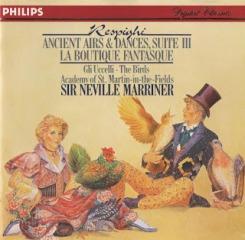Respighi: Ancient Airs & Dances - Suite 3 - La Boutique Fantasque (1987)
Respighi: Ancient Airs & Dances - Suite 3 - La Boutique Fantasque (1987)

Ancient Airs and Dances, Set 3, arrangements (4) for strings, P. 172 1. 1. Italiana (Anon.) 03:19 2. 2. Arie di corte (Jean-Baptiste Besard) 07:20 3. 3. Siciliana (Anon.) 03:07 4. 4. Pasacaglia (Ludovico Roncalli) 03:02 Gli uccelli (The Birds), suite for orchestra, P. 154 5. 1. Preludio (Bernardo Pasquini) 02:56 6. 2. La colomba (Jacques Gallot) 04:58 7. 3. La gallina (Jean-Philippe Rameau) 02:50 8. 4. L'usignuolo (Anon.) 04:56 Buy 9. 5. Il cuccù (Bernardo Pasquini) 04:39 La boutique fantasque, ballet after Rossini, P. 120 10. Overture 02:29 11. Tarantella 01:41 12. Mazurka 02:55 13. Danse cosaque 02:24 14. Cancan 01:43 15. Valse lente 03:51 16. Nocturne 03:48 17. Galop 01:42 Academy of St. Martin-in-the-Fields Neville Marriner - conductor
The most austere of Respighi's Ancient Airs and Dances, the third suite employs the most serious material and calls only for strings, although it works best with a fairly substantial ensemble. As with this work's predecessors, the sources are mostly sixteenth and seventeenth century Italian and French lute and guitar pieces found in turn-of-the-twentieth century transcriptions by Italian musicologist Oscar Chilesotti.
The brief first movement, "Italiana," begins with a graceful anonymous tune in 3/4 time, popular around 1600; Respighi marks it Andantino, and grafts it onto a second piece, part of Santino Garsi da Parma's La Cesarina. Both are galliards, and Respighi tends to provide a pizzicato accompaniment to the long melody lines.
The second movement, "Arie di Corte" (Courtly Airs), is a mini-suite of elegant songs by Jean-Baptiste Besard. Respighi gives rich harmonization to the fluid melodies of contrasting character: "It Is Sad to Be in Love with You" (Andante cantabile), "Farewell Forever, Shepherdess" (Allegretto), "Lovely Eyes That See Clearly" (Vivace), "The Skiff of Love" (Lento con grande espressione), "What Divinity Touches My Soul" (Allegro vivace), and the exuberant "If It Is for My Innocence That You Love Me" (Vivacissimo), with the first song returning to close the movement.
Respighi calls the third movement, generically, "Siciliana," but the melody is the anonymous "Spagnoletta," which was popular in a multitude of arrangements in seventeenth century Spain and Italy. It's a poised, rather pastoral yet somehow formal and slightly melancholy piece that Respighi sends through a couple of variations, with a comparatively loud and extroverted version preceding the lower-key final treatment.
By the standards of these suites, the concluding Passacaglia borders on tragedy (it sometimes calls to mind the final movement of Brahms' Symphony No. 4). Based on the concluding item in Ludovico Roncalli's Capricci Armonici for Baroque guitar, the movement is a series of increasingly dramatic variations over a repeating bass line. --- James Reel, Rovi
Respighi's affection for and knowledge of early music is amply demonstrated in his three suites of Ancient Airs and Dances. Gli ucelli (1928) represents another expedition into the past, in which Respighi transforms five characteristic keyboard pieces from the seventeenth and eighteenth centuries into a genial suite for orchestra.
The orchestration of early keyboard music is a risky undertaking: The bright, uninflected timbre of an instrument like the harpsichord cannot adequately be conveyed by orchestral sonorities. Wisely, Respighi makes no attempt to do so. Instead, he uses the borrowed material to exploit the innate strengths of the orchestra, relying on melodic ingenuity, sparkling instrumental color, and swift contrasts of volume and tempo for interest. While none of these five movements conveys the brittle brilliance of the original pieces, each is witty, playful, and unpretentious.
After a graceful Prelude based on a work by Bernardo Pasquini, the "uccelli" (birds) of the title make their appearances as follows: the dove (after Jacques de Gallot), the hen (after Jean-Phillippe Rameau), the nightingale (Anonymous, seventeenth century), and the cuckoo (after Pasquini). The Prelude's main theme returns in various guises throughout, and the work ends with a restatement of melodic fragments from earlier movements. --- Roy Brewer, Rovi
After writing his opera William Tell in 1829, Rossini, while still a young man, decided to retire from full-time composition, though he continued to write piano pieces for his own amusement. The ballet music La boutique fantasque (The Fantastic Toy Shop), taken from some of these unpublished miniatures, could have no better advocate than Respighi, whose orchestral flair and Italianate bravura perfectly matched Rossini's lively tunes.
Like another nineteenth century ballet, Coppélia by Delibes, the ballet concerns a toy shop in which the toys come to life. A pair of can-can dancers who have been sold, respectively, to an American and a Russian family, decide to flee in order to avoid separation. Their owners return in fury, but are driven from the shop by the other toys. This pleasingly silly story is irrelevant to the music itself, which consists of an Overture followed by a set of dances -- Tarantella, Mazurka, Can-Can, Galop, and Finale. But, thanks to the enduring popularity of the ballet (written for Diaghilev's Ballets Russes), Respighi's arrangement and deft orchestration have forstalled the almost certain extinction of this delightfully light and high-spirited music. A similar service to Rossini was later performed by Benjamin Britten in an equally sparkling version of the Tarantella. --- Roy Brewer, Rovi
download: uploaded yandex 4shared mediafire solidfiles mega filecloudio nornar anonfiles ziddu
Zmieniony (Poniedziałek, 07 Kwiecień 2014 10:26)
